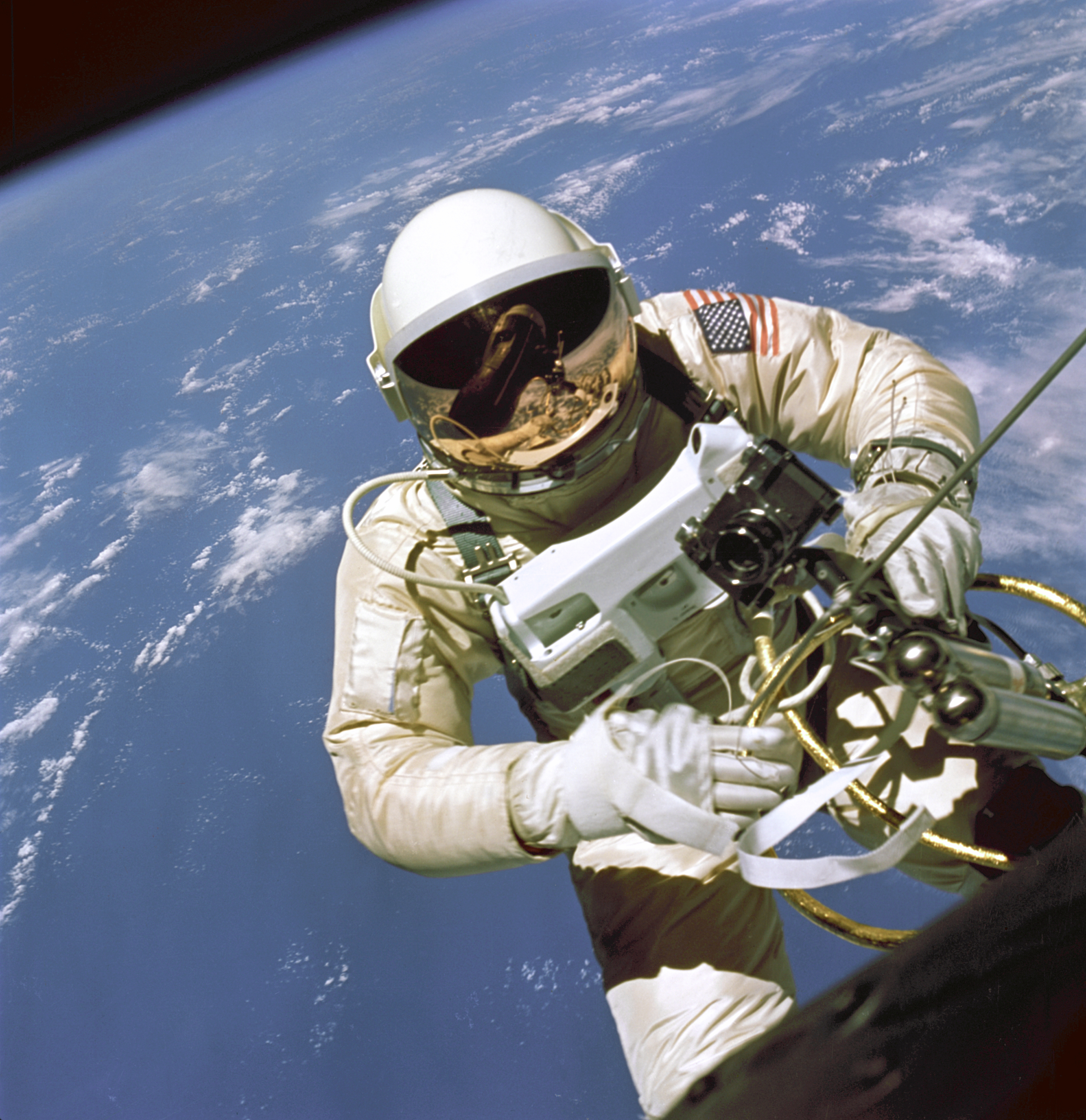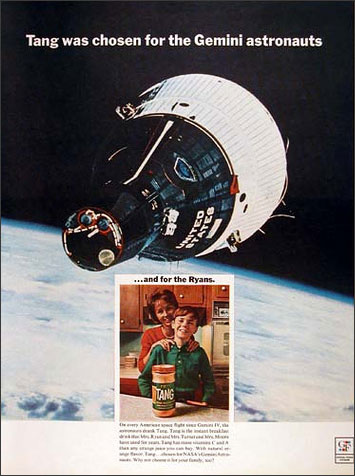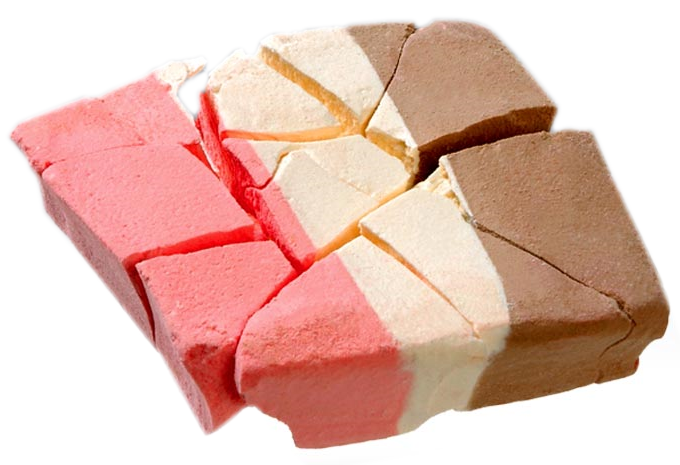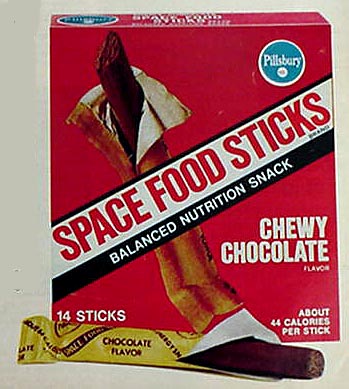HOW ASTRO EATING LAUNCHED 3 FOOD FADS

 Things were supposed be so different by now. Futurists predicted that by the 21st Century we’d travel in helicopter cars, vacation on Mars and wear those nifty space jumpsuits.
Things were supposed be so different by now. Futurists predicted that by the 21st Century we’d travel in helicopter cars, vacation on Mars and wear those nifty space jumpsuits.
It didn’t turn out that way.
One thing they especially got wrong was food. Yet Americans’ fascination with the early Space Age did send folks over the Moon for several astronaut-related products.
Time to revisit three food fads from a future that wasn’t.
 NASA’s early programs seized the country’s fascination like nothing ever had. Space was hip, cool, trendy. And one item shouted “space” like no other: Tang.
NASA’s early programs seized the country’s fascination like nothing ever had. Space was hip, cool, trendy. And one item shouted “space” like no other: Tang.
It burst onto the scene when John Glenn drank it during his Friendship 7 flight on February 7, 1962, one of several items he consumed to test eating in orbit. General Mills shrewdly capitalized on it. Everyday folks could taste the glamour of space flight themselves right in their own kitchen.
 Tang was the brainchild of prominent food scientist William Miller. He also gave us Cool Whip, powdered egg whites and an exploding candy that had absolutely no connection to space, despite urban myths to the contrary: Pop Rocks. They disappeared for a while 30 years ago and later returned. Tang has always been available.
Tang was the brainchild of prominent food scientist William Miller. He also gave us Cool Whip, powdered egg whites and an exploding candy that had absolutely no connection to space, despite urban myths to the contrary: Pop Rocks. They disappeared for a while 30 years ago and later returned. Tang has always been available.
Then there was Astronaut Ice Cream. It was freeze dried to eliminate water and sealed in a pouch, removing the need for refrigeration. It also removed anything recognizable to human taste buds. I’ve had some; it tastes like fiberglass insulation.
 However, despite “astronaut” in its name, the stuff never made it into space. NASA hired Whirlpool to produce freeze dried foods that could be used during long trips to the Moon. Yet this one didn’t go, in spite of widespread claims to the contrary.
However, despite “astronaut” in its name, the stuff never made it into space. NASA hired Whirlpool to produce freeze dried foods that could be used during long trips to the Moon. Yet this one didn’t go, in spite of widespread claims to the contrary.
A report somehow made it into the press that Astronaut Ice Cream was consumed during Apollo 7’s mission in 1968. But it wasn’t. Astronaut Walter Cunningham ought to know; he served on that mission and later told an interviewer, “We didn’t have any of that stuff.”
Astronaut Ice Cream still has a following among hikers and campers because it’s light and occupies little room. Tastiness, apparently, is incidental.
 Which brings us to our final product. It had the least imaginative name of all: Space Food Sticks. Unlike Astronaut Ice Cream, this one really did take the E Ticket trip aloft. Scott Carpenter consumed three small food cubes while travelling in Aurora 7, just 90 days after Glenn downed Tang. (Apparently, nobody at Cape Canaveral thought of serving them together as space’s answer to wine and cheese.)
Which brings us to our final product. It had the least imaginative name of all: Space Food Sticks. Unlike Astronaut Ice Cream, this one really did take the E Ticket trip aloft. Scott Carpenter consumed three small food cubes while travelling in Aurora 7, just 90 days after Glenn downed Tang. (Apparently, nobody at Cape Canaveral thought of serving them together as space’s answer to wine and cheese.)
Pillsbury trotted out its version around 1970, calling it a “nutritionally balanced” snack, the granddaddy of today’s energy bars. Instead of bite-sized cubes it was packaged in stick form in a sealed container to appear more “astronauty.”
Mother Powell bought this product for her three Baby Boomer children. I distinctly remember eating them. They weren’t too bad. (Though if you put enough sugar in anything, you guarantee its appeal to a 9-year-old’s palate.)
Pillsbury’s food engineers also invented relish that could be served by the slice, cake that didn’t crumble, and meat that didn’t need to be refrigerated. Surprisingly, there was no demand for them.
Space Food Sticks faded from store groceries as the glory faded from the space program. You can still find them in space museum gift shops and online.
 Futuristic foods from the Final Frontier are now oddities from a bygone era. The trend today is toward natural foods, such as fresh fruits and vegetables, and away from pre-packaged processed edibles. Ironic, isn’t it?
Futuristic foods from the Final Frontier are now oddities from a bygone era. The trend today is toward natural foods, such as fresh fruits and vegetables, and away from pre-packaged processed edibles. Ironic, isn’t it?
And I didn’t get my nifty space jumpsuit, either. Bummer.
Did you find this enjoyable? Please continue to join me each week, and I invite you to read Tell it Like Tupper and share your review!
Curious about Tell It Like Tupper? Here’s a chance to see for yourself. Take a sneak peek at a couple chapters in this free downloadable excerpt.
